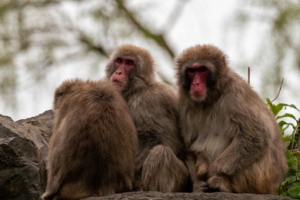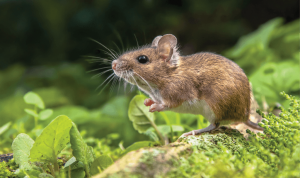The name “monkeypox” ⎼ Viruela símica, 猴痘, variole du singe, vaiolo delle scimmie, Affenpocken, मंकीपॉक्स ⎼ is more than just a “misnomer”.
According to the Oxford English Dictionary (OED), the term “monkeypox”, first defined as “a smallpox occurring in monkeys and apes, especially as a result of deliberate inoculation with matter from human smallpox cases during the preparation of vaccines”, appeared in a JAMA article, published in 1902:
- Monkeys suffer from ‘monkey-pox’, which they acquire by contact with smallpox, and which is somewhat like it. We find that some of the lower animals if brought into intimate contact with human smallpox, acquire a disease that may or may not closely resemble it. Thus, monkeys suffer from “monkey-pox,” which they acquire by contact with smallpox, and which is somewhat like it; sheep acquire ovinia or sheep-pox, which is much less like it; horses’ “grease,” or horsepox, which is still less like it, and cows vaccinia, or cowpox, which is a local disease of the teats and udders.

In this sense, whose usage is now obsolete, “monkeypox” can be compared to the German term “Affenpocken” (1881 or earlier). We do not know, though, whether this disease got its name from this very study.
Also in the OED, “monkeypox” was once described as “a skin disease of humans characterized by the presence of pustules”, as we read about a monkeypox case in a little girl according to the Anita Record Newspaper (1913, 16 Jan.):
Little Miss Marjorie Eneix has been the victim the past week of what is diagnosed by the local physicians as monkey-pox: a disease that is in many respects similar to varioloid.
The Epidemiology of Diseases of Military Importance in the Netherlands Indies manual (U.S. Dept. Navy, 1944: 120) includes monkeypox in a list of “miscellaneous infectious diseases” (e.g., smallpox, measles, mumps, scarlet fever, chickenpox, rabies, etc.), and identifies monkeypox with “pemphigus contagiosus”, also known as impetigo bullosa tropica, which is common, especially where it is warm and humid. This use of the term “monkeypox” is now disused.
Monkeypox was identified in 1958 when two outbreaks of a pox-like disease occurred in colonies of monkeys kept for research. Despite the name, the source of the disease remains unknown. The first human case of monkeypox was officially recorded in medical literature in 1970. Six human infections were reported from the Democratic Republic of the Congo, Liberia, and Sierra Leone. All six patients were unvaccinated; each illness was diagnosed as smallpox based on clinical features of infection.
Believed to have been around for thousands of years, monkeypox is mired in misconception. Its name is misleading: monkeys (and humans) are just incidental hosts of the disease, which is thought to be found primarily in rodents. However, the nomenclature of this virus is not just inaccurate: it is discriminatory and stigmatizing.
Not only in the media and public discourse but also in some scientific literature, monkeypox has been often described as “being African” because it is “endemic” in people in some African countries. The term “endemic”, i.e. a disease that has come to be constantly or normally present in a population or in a geographical region, often implies a sense of equilibrium or stability — but it can also engender apathy, particularly among people who aren’t directly affected by the disease. The problem with the way the term “endemic” is often used is that it can create “the impression that those people’s suffering [in Africa] is to be expected and is acceptable, whereas the suffering that’s happening here as a result of monkeypox is highly exceptional and that we should be responding” (Keletso Makofane).
Nonetheless, it is well established that nearly all monkeypox outbreaks in Africa prior to the 2022 outbreak, have been the result of spillover from animals to humans, and only rarely have there been reports of sustained human-to-human transmissions.
In the context of the current global outbreak, continued reference to, and nomenclature of this virus as “being African” is unacceptable. The need for a new name, with its own definition, is urgent. In fact, a “neutral, non-discriminatory and non-stigmatizing” nomenclature will be more appropriate for the global health community.
In 2015, the World Health Organization (WHO), in consultation and collaboration with the World Organization for Animal Health (OIE) and the Food and Agriculture Organization of the United Nations (FAO), already published a guide for the nomenclature of new human diseases, so that when researchers name diseases, they should seek to minimize unnecessary harm to “trade, travel, tourism or animal welfare, and avoid causing offense to any cultural, social, national, regional, professional or ethnic groups.” Those criteria cited monkeypox as an example, but the WHO didn’t call for revising the name.
We might never know by whom and when the monkeypox disease was named, and if the term comes from English or if it originated from another language (German?), before being translated into English. What we know is that a practical and neutral system of nomenclature may allow efficient communication about the disease without the risk of further misconceptions, discrimination, and stigmatization.
By: Sara Agnelli | Teaching Program Coordinator and Interdisciplinary Academic Advisor
List of sources:
Ladnyj, I. D., Ziegler, P., & Kima, E. (1972). A human infection caused by monkeypox virus in Basankusu Territory, Democratic Republic of the Congo. Bulletin of the World Health Organization, 46(5), 593–597.
Cho, C. T., & Wenner, H. A. (1973). Monkeypox virus. Bacteriological reviews, 37(1), 1–18. https://doi.org/10.1128/br.37.1.1-18.1973
Parker, S., & Buller, R. M. (2013). A review of experimental and natural infections of animals with monkeypox virus between 1958 and 2012. Future virology, 8(2), 129–157. https://doi.org/10.2217/fvl.12.130
Bunge, E. M., Hoet, B., Chen, L., Lienert, F., Weidenthaler, H., Baer, L. R., & Steffen, R. (2022). The changing epidemiology of human monkeypox-A potential threat? A systematic review. PLoS neglected tropical diseases, 16(2), e0010141. https://doi.org/10.1371/journal.pntd.0010141
 2
2
